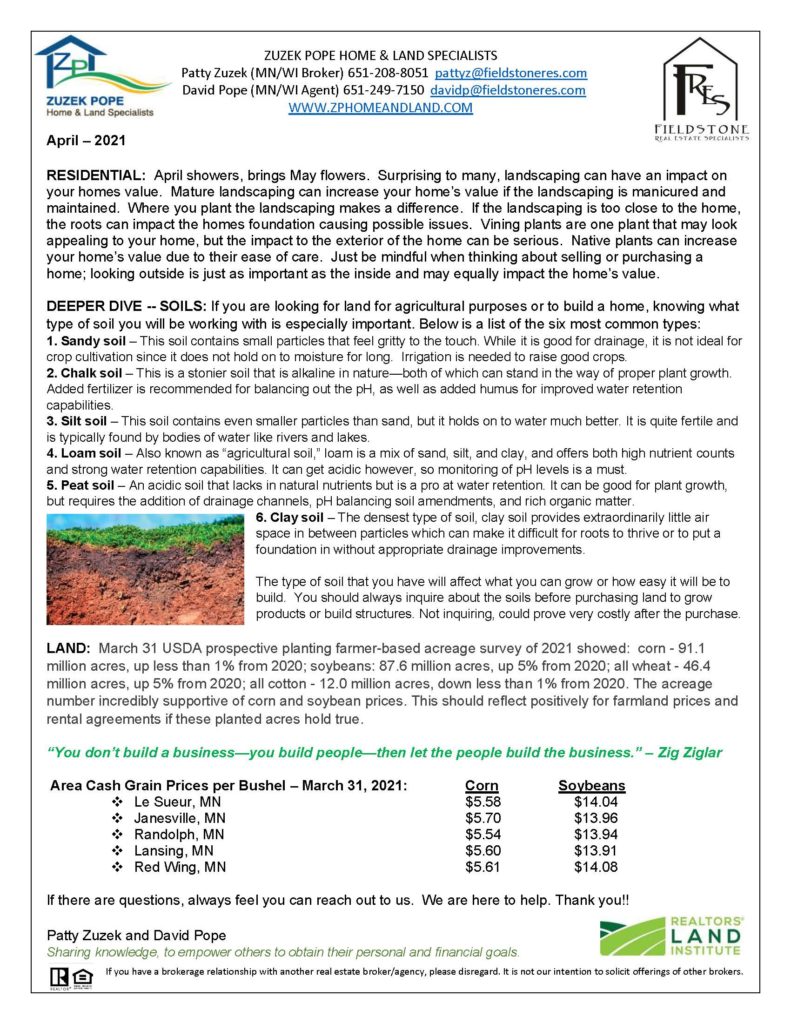
RESIDENTIAL: April showers, brings May flowers. Surprising to many, landscaping can have an impact on your homes value. Mature landscaping can increase your home’s value if the landscaping is manicured and maintained. Where you plant the landscaping makes a difference. If the landscaping is too close to the home, the roots can impact the homes foundation causing possible issues. Vining plants are one plant that may look appealing to your home, but the impact to the exterior of the home can be serious. Native plants can increase your home’s value due to their ease of care. Just be mindful when thinking about selling or purchasing a home; looking outside is just as important as the inside and may equally impact the home’s value.
DEEPER DIVE – SOILS: If you are looking for land for agricultural purposes or to build a home, knowing what type of soil you will be working with is especially important. Below is a list of the six most common types:
- Sandy soil – This soil contains small particles that feel gritty to the touch. While it is good for drainage, it is not ideal for crop cultivation since it does not hold on to moisture for long. Irrigation is needed to raise good crops.
- Chalk soil – This is a stonier soil that is alkaline in nature—both of which can stand in the way of proper plant growth. Added fertilizer is recommended for balancing out the pH, as well as added humus for improved water retention capabilities.
- Silt soil – This soil contains even smaller particles than sand, but it holds on to water much better. It is quite fertile and is typically found by bodies of water like rivers and lakes.
- Loam soil – Also known as “agricultural soil,” loam is a mix of sand, silt, and clay, and offers both high nutrient counts and strong water retention capabilities. It can get acidic however, so monitoring of pH levels is a must.
- Peat soil – An acidic soil that lacks in natural nutrients but is a pro at water retention. It can be good for plant growth, but requires the addition of drainage channels, pH balancing soil amendments, and rich organic matter.
- Clay soil – The densest type of soil, clay soil provides extraordinarily little air space in between particles which can make it difficult for roots to thrive or to put a foundation in without appropriate drainage improvements.
The type of soil that you have will affect what you can grow or how easy it will be to build. You should always inquire about the soils before purchasing land to grow products or build structures. Not inquiring, could prove very costly after the purchase.
LAND: March 31 USDA prospective planting farmer-based acreage survey of 2021 showed: corn – 91.1 million acres, up less than 1% from 2020; soybeans: 87.6 million acres, up 5% from 2020; all wheat – 46.4 million acres, up 5% from 2020; all cotton – 12.0 million acres, down less than 1% from 2020. The acreage number incredibly supportive of corn and soybean prices. This should reflect positively for farmland prices and rental agreements if these planted acres hold true.
Area Grain Prices per Bushel – March 31, 2021:
| Area | Corn | Soybeans |
|---|---|---|
| Le Sueur, MN | $5.58 | $14.04 |
| Janesville, MN | $5.70 | $13.96 |
| Randolph, MN | $5.54 | $13.94 |
| Lansing, MN | $5.60 | $13.91 |
| Red Wing, MN | $5.61 | $14.08 |
If there are questions, always feel you can reach out to us. We are here to help. Thank you!!

 March 2021 Newsletter
March 2021 Newsletter